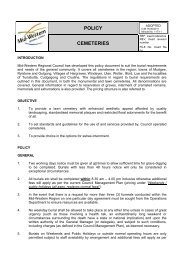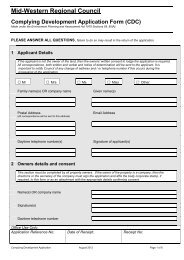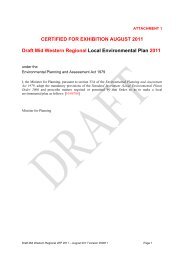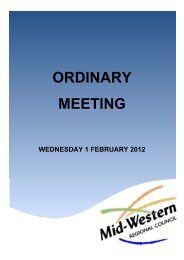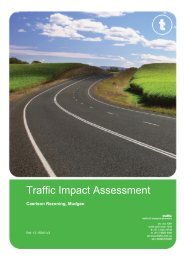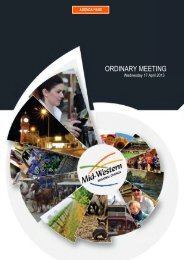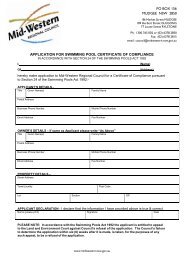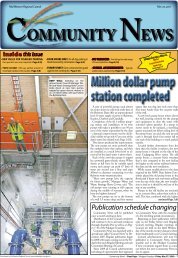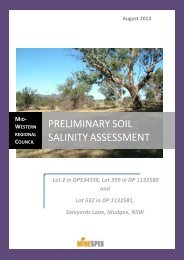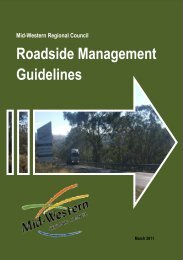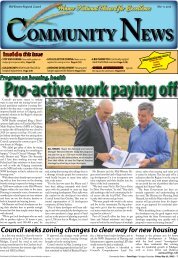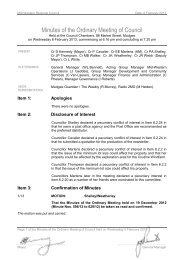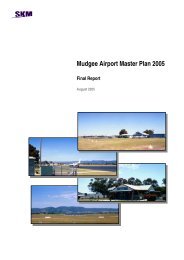3000 kb - Mid Western Regional Council - NSW Government
3000 kb - Mid Western Regional Council - NSW Government
3000 kb - Mid Western Regional Council - NSW Government
You also want an ePaper? Increase the reach of your titles
YUMPU automatically turns print PDFs into web optimized ePapers that Google loves.
Assumptions and Limitations<br />
The projections of the financial plans are based on past financial performance. Allowance<br />
is made for new initiatives, future rate forecasts, and maintenance of sustainable levels of<br />
service as identified in the strategic planning process.<br />
The depreciation is shown in the operating statement but this is not a cash item. The<br />
financial planning model manages the cash flow but keeps a running tally of cumulative<br />
depreciation so that <strong>Council</strong> can appreciate the potential future liability for maintaining the<br />
value in the system and levels of service. By planning ahead and making optimum use of<br />
existing assets, a more cost-effective and efficient service should result.<br />
Average annual residential charge is used as the performance measure representing<br />
overall revenue requirements from residential customers. This should not be confused<br />
with pricing. Pricing, i.e. distribution of the charges according to consumption or special<br />
customer groups, is the subject of a separate revenue planning exercise.<br />
The financial model is not a substitute for normal budgeting (that is, short-term financial<br />
planning). The model assumes that all expenses and income occur at the beginning of the<br />
year and is therefore not appropriate to track cash flow throughout the year. It is<br />
important, however, that the budgeting process is carried out within the framework of the<br />
long-term financial plan.<br />
The Capital Works Plan provides a guide for estimation of long-term operation and<br />
maintenance costs. It is accepted that the level of confidence in these projections reduces<br />
with time but it is important to identify as many future commitments and liabilities as<br />
possible.<br />
The Modelling Process<br />
Phase 1 – Initial runs<br />
The objective of Phase 1 development is<br />
to present a first cut model of options for<br />
future service provision. Comparison of<br />
outcomes enables <strong>Council</strong> to make<br />
decisions as to the preferred model and<br />
the most beneficial and practical funding<br />
solution for the proposed asset<br />
management programs.<br />
Funding<br />
In considering funding for future options<br />
there are three basic options:<br />
• Fund all capital works from<br />
revenues.<br />
• Borrow to fund all capital<br />
works.<br />
• Fund capital works from a<br />
mix of borrowing and<br />
revenue<br />
Most councils would prefer to avoid<br />
borrowing to fund their capital works<br />
programs if possible. This strategy<br />
obviously avoids incurring interest<br />
Base Case<br />
Scenario<br />
Assumptions<br />
Strategy<br />
Affordability<br />
Phase2 BRIEF<br />
Phase1 REVIEW<br />
Review base data:<br />
Interest Rates<br />
Developer Charges<br />
etc<br />
Funding options<br />
Debt ratio<br />
Cash liquidity<br />
etc.<br />
Delay capital works<br />
Delete projects<br />
Use structured<br />
loans<br />
Page 82 Part C - Detailed Information <strong>Mid</strong>-<strong>Western</strong> <strong>Regional</strong> <strong>Council</strong><br />
Strategic Business Plan for Sewerage



